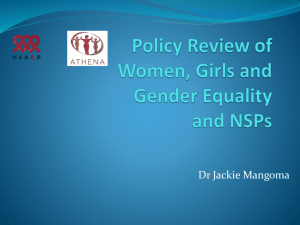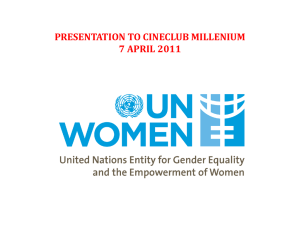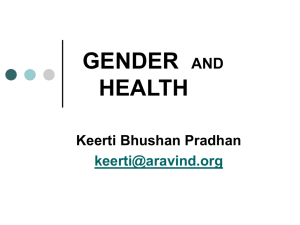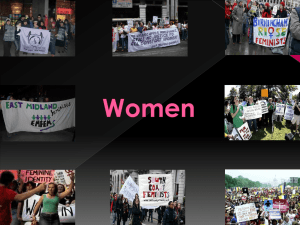Advancing a Gender-Based Development Agenda POLICY RECOMMENDATIONS Charles Kenny and Sarah Dykstra
advertisement
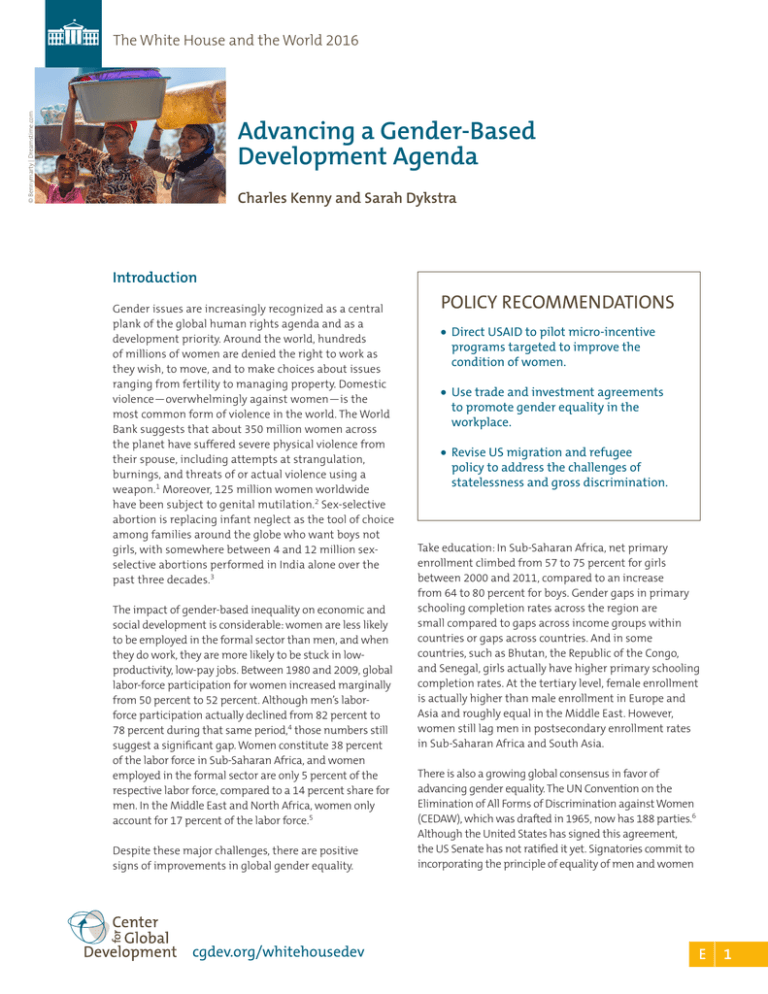
© Bennymarty | Dreamstime.com The White House and the World 2016 Advancing a Gender-Based Development Agenda Charles Kenny and Sarah Dykstra Introduction Gender issues are increasingly recognized as a central plank of the global human rights agenda and as a development priority. Around the world, hundreds of millions of women are denied the right to work as they wish, to move, and to make choices about issues ranging from fertility to managing property. Domestic violence—overwhelmingly against women—is the most common form of violence in the world. The World Bank suggests that about 350 million women across the planet have suffered severe physical violence from their spouse, including attempts at strangulation, burnings, and threats of or actual violence using a weapon.1 Moreover, 125 million women worldwide have been subject to genital mutilation.2 Sex-selective abortion is replacing infant neglect as the tool of choice among families around the globe who want boys not girls, with somewhere between 4 and 12 million sexselective abortions performed in India alone over the past three decades.3 The impact of gender-based inequality on economic and social development is considerable: women are less likely to be employed in the formal sector than men, and when they do work, they are more likely to be stuck in lowproductivity, low-pay jobs. Between 1980 and 2009, global labor-force participation for women increased marginally from 50 percent to 52 percent. Although men’s laborforce participation actually declined from 82 percent to 78 percent during that same period,4 those numbers still suggest a significant gap. Women constitute 38 percent of the labor force in Sub-Saharan Africa, and women employed in the formal sector are only 5 percent of the respective labor force, compared to a 14 percent share for men. In the Middle East and North Africa, women only account for 17 percent of the labor force.5 Despite these major challenges, there are positive signs of improvements in global gender equality. cgdev.org/whitehousedev POLICY RECOMMENDATIONS • Direct USAID to pilot micro-incentive programs targeted to improve the condition of women. • Use trade and investment agreements to promote gender equality in the workplace. • Revise US migration and refugee policy to address the challenges of statelessness and gross discrimination. Take education: In Sub-Saharan Africa, net primary enrollment climbed from 57 to 75 percent for girls between 2000 and 2011, compared to an increase from 64 to 80 percent for boys. Gender gaps in primary schooling completion rates across the region are small compared to gaps across income groups within countries or gaps across countries. And in some countries, such as Bhutan, the Republic of the Congo, and Senegal, girls actually have higher primary schooling completion rates. At the tertiary level, female enrollment is actually higher than male enrollment in Europe and Asia and roughly equal in the Middle East. However, women still lag men in postsecondary enrollment rates in Sub-Saharan Africa and South Asia. There is also a growing global consensus in favor of advancing gender equality. The UN Convention on the Elimination of All Forms of Discrimination against Women (CEDAW), which was drafted in 1965, now has 188 parties.6 Although the United States has signed this agreement, the US Senate has not ratified it yet. Signatories commit to incorporating the principle of equality of men and women E |1 The White House and the World 2016 in their legal system, abolishing all discriminatory laws, adopting legislation prohibiting discrimination against women, and establishing institutions to ensure the effective protection of women against discrimination. The time is right for global leadership to bolster the growing consensus that gender equality is a moral imperative and a development priority. Domestically, there is also bipartisan agreement on the importance of gender equality to US foreign policy goals. In 2007, Secretary Condoleezza Rice suggested: The same ideals that guided America’s earliest women of courage now lead our country into the world to combat the dehumanization of women in every form. We will not accept that women and girls are sold into modern-day slavery. We will not accept that women and girls are denied an education. We will not accept so-called honor killings, and we’ll do everything that we can to end forced early marriages. And we will work to improve healthcare opportunities for all women so that they can help to build a more hopeful future for themselves and for their own children.7 In 2013, President Obama issued a memorandum stating: Promoting gender equality and advancing the status of all women and girls around the world remains one of the greatest unmet challenges of our time. . . . Ensuring that women and girls, including those most marginalized, are able to participate fully in public life, are free from violence, and have equal access to education, economic opportunity, and healthcare increases broader economic prosperity, as well as political stability and security.8 The United States has played an important role in championing women’s rights in international agreements, as well as supporting programs aimed at mitigating and reducing discrimination against women through diplomacy and aid programs. The world’s remaining superpower can make (and has made) a large difference by promoting the norm of gender equality. With a relatively small financial and diplomatic investment, the United States could make a significantly greater impact. The next US president should bolster the US role by strategically using foreign assistance, as well as migration, trade, and investment tools, to signal that continuing injustices faced by women around the world are unacceptable and to act to mitigate and alleviate the impact of such injustices on their victims. 2 |E The Role of Local Norms and Institutions Local norms and national institutions are two leading factors in the continuing inequities faced by women. These norms include attitudes about the place of women in the family and society, as well as the laws that frequently reflect such attitudes. With regard to violence, approximately one-quarter of women worldwide suggest that wife beating can be justified if she does something like argue with her husband or burn dinner. Women who agree with any justification for wife beating are at a considerably higher risk of violence than those who do not.9 Formal institutions both reflect and reinforce these attitudes. Nearly 100 countries allow girls to marry before the age of 18 with parental consent, and 54 countries permit girls to marry at ages between one and three years younger than boys.10 Being married before the age of 18 is associated with an increased risk of violence, whereas completing secondary education is associated with a one-third reduction in risk. Norms can change, however—not least through the use of monetary and social incentives to adopt different behaviors. And for all that institutions tend to reflect local norms, legal change can be a force to change both those norms and the behaviors that result. While the link between passing a law against child marriage and reductions in actual child marriage appears at best partial in many countries, it is an important step in changing behaviors over time.11 In 1989, only three countries worldwide had legislation against domestic violence; today, that number is 76. In the surveyed developing countries with such legislation, 40 percent of women accept domestic violence as justifiable, compared with 57 percent in the sample countries without legislation. Moreover, each additional year that a country has domestic violence legislation in place is associated with a reduced prevalence of about two percentage points. It is a similar story with regard to jobs around the world— norms surely influence the shape of laws, but norms can change, and legal reform can foster changes in both attitudes and behaviors. Many men and women across the world think it is more important that men get jobs. The World Values Survey asks respondents around the world: “Do you think that when jobs are scarce, men have more right to a job than women?” In the United States, 6 percent agree with that idea; in Spain, it is 12 percent. In the Philippines, Algeria, Morocco, and Turkey, it is over half, and in Nigeria, Egypt, Jordan, and Pakistan, it is above two-thirds. Advancing a Gender-Based Development Agenda Because of views about “proper” jobs for women, many countries still have laws on the books that ban them from specific positions. In Russia, for example, women are barred from working as freight train conductors, sailors, high-antenna installers, or drivers of loading machines. And Russia is hardly alone: 79 different countries restrict the type of jobs women can perform solely on the grounds of their sex. Meanwhile, 15 countries, including Bolivia, Cameroon, Jordan, and Sudan, allow husbands to prevent their wives from accepting jobs.12 Figure 1 color-codes countries based on the number of restrictions they place on women’s employment, from none to many. Unsurprisingly, countries that impose work hour or industry restrictions have lower female labor force participation rates (45 percent compared to 60 percent in countries with no restrictions).13 At the same time, the World Bank’s Women, Business, and the Law Survey suggests that for the measures for which historical data are available, more than half of the restrictions on women’s economic activities that were in place in 1960 had been removed by 2010. Greater gender parity in legal rights is associated with higher female participation in the labor force, ownership of firms, and income equality. Local norms surrounding women’s identity in the family are also reflected in nationality laws. Article 9 of CEDAW recognizes the right of women to confer nationality to their children; however, this provision has been weakened by the number of states that have entered reservations or caveats to this article.15 Even now, 27 countries prevent women from passing their nationality onto their children. This gender discrimination results in statelessness among children in cases where the father is without a nationality or when he is unable (or unwilling) to pass his nationality onto his children under the law of his state. Women are also vulnerable to becoming stateless in the 60 countries that do not permit women to acquire, change, or retain nationality in the same way as men.16 The impact is severe for the estimated 12 million stateless persons around the world.17 Stateless individuals have no rights to participate in political processes and are often prevented from owning property. Depending on their country of residence, they may be prevented from registering births or marriages, working legally, or accessing education and health systems. Stateless people are at risk of protracted periods of detention during deportation proceedings. Figure 1 Laws against Women Working14 Restrictions on Restrictions on Employment Restrictions onEmployment Employment 00 0 5 55 11 1 6 66 2 7 2 2 77 3 >8 3 >8 3 >8 No data 4 4 No data No data 4 Source: Authors’ calculations using the World Bank’s Women, Business, and the Law database E |3 The White House and the World 2016 Stateless women and children are also at a higher risk of abuse and exploitation, including human trafficking. As with child marriage, domestic violence, and labor force participation, significant progress has been made in reforming discriminatory nationality laws. Sixty years ago, a majority of countries prevented women from conferring nationality to their children. Most countries have already removed these restrictions, including 11 countries during the past decade. Currently, several more countries are considering reforms.11 Existing US Programs and Initiatives US diplomacy and policy aim to play an important role in shifting norms and legislation in developing countries. In 2009, President Barack Obama established an Office of Global Women’s Issues within the State Department. This office, headed by an ambassador at large and with a fiscal year 2014 budget of $20 million, works to ensure that women’s rights are a central element of US foreign policy and monitors human trafficking worldwide. Together, the US Agency for International Development (USAID) and the State Department have developed a strategy focused on preventing genderbased violence. 18 To date, however, the United States has largely used the bully pulpit to advance gender equality, while committing minimal resources to programs with this aim and eschewing use of trade, investment, and migration tools. USAID is a significant global funder of family planning and reproductive health, directing about $500 million a year to programs in this area. In addition, programs such as the President’s Emergency Plan for AIDS Relief (PEPFAR) have pregnant women as priority recipients for assistance. USAID also supports activities that promote women’s leadership and empowerment (budgeted at $65 million over four years), prevent and respond to gender-based violence, and encourage women’s inclusion in peace building. It integrates gender equality across sectors strategies, project design, and monitoring and evaluation activities.19 In terms of specific programs, the agency highlights the example of $30 million in funding directed to support women’s leadership across the world—in particular, “supporting women’s direct participation in peace negotiations, humanitarian and post-conflict donor conferences, and government and political transitions.”20 USAID also allocated $32 million in 2010 to prevent and respond to gender-based violence in the Democratic Republic of Congo through access to health care, legal services, and police training.21 4 |E However, specific gender and development projects are relatively rare in USAID (a fact reflected in the lack of aggregate data on projects with the primary aim of increasing women’s empowerment), and some of the most effective approaches have not been tried. Other governments and donor agencies have made effective use of conditional cash transfers to influence health behaviors and norms around the world. Often, these transfers have been directed toward women.22 New research shows that small incentives can help women and girls overcome barriers by creating space for them to make better choices for their health and well-being. For instance, cash transfer programs funded by the World Bank were shown to keep girls in school and avoid early marriage in Bangladesh and to effectively prevent HIV and early pregnancies in Malawi.24 USAID has yet to fund such an initiative. Outside of USAID, the State Department’s Gender-Based Violence Emergency Response and Protection Initiative will support local nongovernment organizations working to address this issue and will give grants of up to $5,000 to victims. However, this initiative received roughly $500,000 for its first year in 2014,25 suggesting (again) limited financial commitment. The US government secured a UN Human Rights Council resolution on women’s and children’s right to a nationality. The resolution urged countries “to refrain from enacting or maintaining discriminatory nationality legislation and to reform nationality laws that discriminate against women.”26 In 2011, the Department of State launched the Women’s Nationality Initiative to help address the issue of statelessness caused by gender discrimination in Benin, Nepal, and Qatar.27 While the goal of the initiative is commendable, there is currently little information in the public domain about the activities carried out or what their impact might be. With regard to the tool of refugee status, fear of female genital mutilation has been a grounds for granting asylum in specific cases since 1996. In a landmark ruling in August 2014, the US Justice Department’s Board of Immigration Appeals concluded that married women in Guatemala who cannot escape their spouses were potentially deserving of refugee status because of the risk of violence they face and the limited likelihood of government protection. This ruling considerably expands the potential opportunity to use refugee status not only as a tool to protect women from violence and discrimination but also for the United States to signal country cases where women are subject to treatment significantly outside international norms. Advancing a Gender-Based Development Agenda However, the United States does not currently use migration policy as a tool to address gender discrimination in nationality laws around the world. Under current law, it is nearly impossible for stateless individuals to obtain residency, asylum, or citizenship in the United States, because they have no recognized legal status. Two proposed bills aim to remedy this situation, which is often a result of gender discrimination.28 Both of these bills propose to provide new protections for stateless persons by authorizing the secretary of Homeland Security or the US attorney general to grant conditional lawful status to certain groups of stateless persons already residing in the United States. This status would allow stateless individuals to work in the United States and provides a path to permanent residence after one year. Policy Recommendations The next US president, working closely with Congress, should build on existing State Department and USAID efforts to expand the US government’s ambitions to improve gender equality throughout the world. This would include pursuing a balanced mix of targeted aid programs to change local norms, as well as using trade, investment, and migration policy tools to foster change in legal barriers to gender equality. u Use US assistance to foster changes in norms and behavior at the local level. The next presidential administration should press for USAID pilots that incorporate micro-incentive programs to create favorable conditions for women’s empowerment, including the prevention of gender-based violence and early marriage and the improvement of girls’ school completion rates. This would require a change in USAID priorities but no change in national laws in recipient countries. The average disbursement in a recent Malawian conditional cash transfer program targeting girls’ education and HIV status was $10 per month per family during the school year, or about $100 per year, with $3 per month going to the girls themselves.29 Program participants were three to four times more likely to be in school at the end of the year than nonparticipants and had an HIV prevalence that was 60 percent lower than the control group. A similar program could be scaled to cover 600,000 girls (approximately the population of 15- to 19-year-old females in a country like Rwanda) at a total cost of $60 million per year. v Use US trade and investment treaties to foster greater gender equality in the workplace. US bilateral trade and investment treaties frequently contain language about labor laws and working conditions. For instance, US bilateral investment treaties include standard language that neither party shall weaken labor standards in an effort to attract investment. In addition, there is standard language mandating that neither party may restrict senior management positions on the basis of any particular nationality.30 Some trade pacts include specific mention of gender issues. For instance, the Peru Free Trade Agreement includes a labor cooperation and capacity-building mechanism for pursuing bilateral or regional cooperation activities on labor issues, such as “development of programs on gender issues, including the elimination of discrimination in respect of employment and occupation.”31 The next US president could instruct the US Trade Representative (USTR) to include support in future trade and investment treaties to pursue cooperation activities focused on the elimination of gender discrimination. In addition, future trade and investment treaties could also mandate that “neither party may require that an enterprise of that party that is a covered investment deny employment on the grounds of race, religion, gender, or sexual orientation.” Such action would not require changes to existing US legislation; instead, it would simply require that the USTR prioritize these requirements in future negotiations. w Use US migration and refugee policy to highlight and respond to the challenges of statelessness and gross discrimination. While the recent expansion of asylum status for married women from Guatemala who cannot escape their spouses is a welcome step, the guidelines and regulations on asylum and refugee status of women facing human rights abuses remain patchy and limited. The next US president should instruct the attorney general, in conjunction with the secretary of the Department of Homeland Security, to promulgate rules and regulations clarifying that women from countries where the right to free movement or employment is expressly and egregiously limited by law form part of a particular social grouping potentially eligible for asylum and refugee status. Asylum seekers who have attempted to exercise that right and been prevented under the auspices of the law would have potential eligibility for asylum. E |5 The White House and the World 2016 In December 2011, then Secretary of State Hilary Clinton pledged to work with Congress to introduce legislation that provides a mechanism for stateless persons to obtain residency and eventually citizenship.32 While no mechanism currently exists, previously introduced legislation includes provisions that would fulfill this pledge. The next presidential administration, led by the secretary of Homeland Security and attorney general, should work closely with Congress to enact legislation that provides the stateless with a path to citizenship. Further Reading Christina Droggitis, Nandini Oomman, and David Wendt, “Going Beyond Gender as Usual: Why and How Global HIV/AIDS Donors Can Do More for Women and Girls.” CGD Policy Brief. Washington: Center for Global Development, 2009. Esther Duflo. “Women Empowerment and Economic Development.” Journal of Economic Literature 50(4): 1051–79. Amanda Glassman, Denizhan Duran, and Marge Koblinsky. “Impact of Conditional Cash Transfers on Maternal and Newborn Health.” Journal of Health, Population and Nutrition 31(4[supplement 2]): S48–S66. Ruth Levine, Cynthia B. Lloyd, Margaret Greene, and Caren Grown. Girls Count: A Global Investment & Action Agenda. Washington: Center for Global Development, 2009. World Bank. World Development Report 2012: Gender Equality and Development. Washington: World Bank Group, 2012. 6 |E Advancing a Gender-Based Development Agenda Notes World Bank, Voice and Agency: Empowering Women and Girls for Shared Prosperity (Washington: World Bank, 2014). 1 UNICEF, Female Genital Mutilation/Cutting: A Statistical Overview and Exploration of the Dynamics of Change (New York: UNICEF, 2013). 2 Prabhat Jha et al., “Trends in Selective Abortions of Girls in India: Analysis of Nationally Representative Birth Histories from 1990 to 2005 and Census Data from 1991 to 2011,” The Lancet 377(9781): 1921–8. 3 World Bank, World Development Report 2012: Gender Equality and Development (Washington, DC: World Bank, 2012). 4 Hugo Nopo, Nancy Daza, and Johanna Ramos, “Gender Earnings Gaps in the World,” Discussion Paper No. 5736, Institute for the Study of Labor, Bonn, Germany, 2011. 5 6 United Nations, “CEDAW,” www.un.org/womenwatch/daw/cedaw/. See Condoleeza Rice, “Remarks on International Women’s Day,” March 7, 2007, http://2001-2009.state.gov/secretary/rm/2007/ mar/81518.htm . 7 See White House, “Presidential Memorandum—Coordination of Policies and Programs to Promote Gender Equality and Empower Women and Girls Globally,” press release, January 30, 2013, www.whitehouse.gov/the-press-office/2013/01/30/ presidential-memorandum-coordination-policies-andprograms-promote-gende. 8 9 World Bank, World Development Report 2012. Jody Heymann and Kristen McNeill, Changing Children’s Chances: New Findings on Child Policy Worldwide (Los Angeles: World Policy Analysis Center, 2013). 10 Matt Collin and Theodore Talbot, “Does Banning Child Marriage Really Work?” CGD Views from the Center (blog), August 22, 2014, www.cgdev.org/blog/does-banning-childmarriage-really-work. 11 World Bank, Women, Business, and the Law (Washington, DC: World Bank Group, 2014). 12 13 World Bank, World Development Report 2012. Authors’ calculations using the World Bank’s Women, Business, and the Law database. Department of State and USAID, United States Strategy to Prevent and Respond to Gender-Based Violence Globally (Washington: Department of State and USAID, 2012). 18 Department of State, Congressional Budget Justification: Department of State, Foreign Operations and Related Programs, Fiscal Year 2015 (Washington: Department of State, 2014). 19 See USAID, “Highlights: Gender Equality & Women’s Empowerment,” www.usaid.gov/sites/default/files/ documents/2155/Highlights_May%202013_1.pdf. 20 See Embassy of the United States–Kinshasa, Congo, “USAID Awards More Than $32 Million to Address Sexual and GenderBased Violence in Eastern DRC,” press release, July 21, 2010, http:// kinshasa.usembassy.gov/pressrelease_07212010_english.html. 21 Amanda Glassman, Jessica Todd, and Marie Gaarder, “Cash Transfers to Support Better Household Decisions,” in Performance Incentives for Global Health: Potential and Pitfalls, ed. Ruth Levine (Washington: Center for Global Development, 2009). 22 See, for example, Seo Yeon Hong and Leopold Remi Sarr, LongTerm Impacts of the Free Tuition and Female Stipend Programs on Education Attainment, Age of Marriage, and Married Women’s Labor Market Participation in Bangladesh (Washington: World Bank, 2012) and Sarah Baird, Craig McIntosh, and Berk Özler, “Effect of a Cash Transfer Programme for Schooling on Prevalence of HIV and Herpes Simplex Type 2 in Malawi: A Cluster Randomised Trial,” The Lancet 379(9823): 1320–9. 23 See “Gender-Based Violence Emergency Response and Prevention Initiative,” www.publicsafetygrants.info/ GrantDetails.aspx?gid=34342. 25 See Department of State, “The Right to a Nationality: Women and Children Human Rights Council: 20th Session ,” media note, July 5, 2012, www.state.gov/r/pa/prs/ps/2012/07/194615.htm. 26 See Department of State, “Bureau of Population, Refugees, and Migration ,” fact sheet, March 8, 2012, www.state.gov/j/ prm/releases/releases/2012/185416.htm. 27 See Border Security, Economic Opportunity, and Immigration Modernization Act, S. 744, Sec. 3405, and The Refugee Protection Act of 2013, S. 645, Sec. 17. 28 See Sarah Baird et al., “The Short-Term Impacts of a Schooling Conditional Cash Transfer Program on the Sexual Behavior of Young Women,” http://irps.ucsd.edu/assets/033/10615.pdf. 29 14 United Nations, “Reservations to CEDAW,” www.un.org/ womenwatch/daw/cedaw/reservations.htm. 15 UN High Commissioner for Refugees (UNHCR), “Background Note on Gender Equality, Nationality Laws and Statelessness,” UNHCR, Geneva, 2014. 16 UNHCR, “Media Backgrounder: Millions Are Stateless, Living in Legal Limbo,” UNHCR, Geneva, 2011. 17 See “Treaty between the United States of America and the Oriental Republic of Uruguay concerning the Encouragement and Reciprocal Protection of Investment,” available at www.ustr. gov/sites/default/files/uploads/agreements/bit/asset_upload_ file748_9005.pdf. 30 See the Peru Free Trade Agreement, chapter 17, available at www.ustr.gov/sites/default/files/uploads/agreements/fta/ peru/asset_upload_file73_9496.pdf. 31 UNHCR,Pledges 2011: Ministerial Intergovernmental Event on Refugees and Stateless Persons (Geneva: UNHCR, 2012). 32 For more information please contact Beth Schwanke, CGD senior policy counsel, at bschwanke@cgdev.org. E |7

